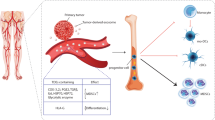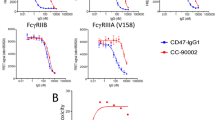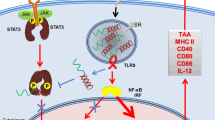Abstract
The tumor microenvironment represents a burden that hampers the proper activation of immune cells, including the dendritic cells (DCs). It is, therefore, desired that the important characteristics of a given anticancer drug candidate be seen as consisting not solely of its antitumor properties, but that it also lacks potential side effects that could additionally constrain the development and function of immune cells associated with tumor immunity. We have previously identified compounds with a N-amidinopiperidine scaffold that selectively induce apoptosis in Burkitt’s lymphoma cells through proteasome inhibition. Here, we demonstrate that SPI-15 affected neither the viability of DCs nor their differentiation. In addition, the compound had no significant effect on their cytokine secretion or allostimulatory capacity. Moreover, DC functionality in the context of tumor microenvironment was also unaffected, as demonstrated by experiments performed on DCs differentiated in Ramos-conditioned media in the presence or absence of SPI-15. The cytokine profile and functional assays revealed that SPI-15 rescues DC differentiation from the immunosuppressive environment produced by Ramos cells; this was seen by their reacquired ability to induce IFN-γ-secretion from naïve CD4+CD45RA+ T cells and the consequently induced Th1-effector differentiation. Herein, we present novel characteristics of an N-amidinopiperidine-based protease inhibitor whose anticancer properties are not associated with the immunosuppression of DCs. We propose future studies toward the design of structurally similar compounds with the aim of developing potent anticancer drugs with minimal negative effects on crucial factors involved in tumor immunity.






Similar content being viewed by others
Abbreviations
- CCR7:
-
C–C chemokine receptor type 7
- DCs:
-
Dendritic cell
- DC-SIGN:
-
Dendritic cell-specific intercellular adhesion molecule-3-grabbing non-integrin
- HLA-DR:
-
Human leukocyte antigen D-related
- IDO:
-
Indoleamine-2,3-dioxygenase
- LPS:
-
Lipopolysaccharide
- MHC:
-
Major histocompatibility complex
- MLR:
-
Mixed lymphocyte reaction
- MSR-1:
-
Macrophage scavenger receptor 1
- NfκB:
-
Nuclear factor κB
- PRRs:
-
Pattern recognition receptors
- SPI-15:
-
Serine protease inhibitor 15
- TCR:
-
T cell receptor
- TGF-β:
-
Transforming growth factor β
- TLR:
-
Toll-like receptor
References
Wu J (2002) On the role of proteasomes in cell biology and proteasome inhibition as a novel frontier in the development of immunosuppressants. Am J Transplant 2(10):904–912. doi:10.1034/j.1600-6143.2002.21006.x
Adams J (2004) The proteasome: a suitable antineoplastic target. Nat Rev Cancer 4(5):349–360. doi:10.1038/nrc1361nrc1361
McConkey DJ, Zhu K (2008) Mechanisms of proteasome inhibitor action and resistance in cancer. Drug Resist Updat 11(4–5):164–179. doi:10.1016/j.drup.2008.08.002
Sun K, Welniak LA, Panoskaltsis-Mortari A, O’Shaughnessy MJ, Liu H, Barao I, Riordan W, Sitcheran R, Wysocki C, Serody JS, Blazar BR, Sayers TJ, Murphy WJ (2004) Inhibition of acute graft-versus-host disease with retention of graft-versus-tumor effects by the proteasome inhibitor bortezomib. Proc Natl Acad Sci U S A 101(21):8120–8125. doi:10.1073/pnas.04015631010401563101
Koreth J, Alyea EP, Murphy WJ, Welniak LA (2009) Proteasome inhibition and allogeneic hematopoietic stem cell transplantation: a review. Biol Blood Marrow Transplant 15(12):1502–1512. doi:10.1016/j.bbmt.2009.07.016
Nencioni A, Schwarzenberg K, Brauer KM, Schmidt SM, Ballestrero A, Grunebach F, Brossart P (2006) Proteasome inhibitor bortezomib modulates TLR4-induced dendritic cell activation. Blood 108(2):551–558. doi:10.1182/blood-2005-08-3494
Nencioni A, Garuti A, Schwarzenberg K, Cirmena G, Dal Bello G, Rocco I, Barbieri E, Brossart P, Patrone F, Ballestrero A (2006) Proteasome inhibitor-induced apoptosis in human monocyte-derived dendritic cells. Eur J Immunol 36(3):681–689. doi:10.1002/eji.200535298
Banchereau J, Briere F, Caux C, Davoust J, Lebecque S, Liu YJ, Pulendran B, Palucka K (2000) Immunobiology of dendritic cells. Annu Rev Immunol 18:767–811. doi:10.1146/annurev.immunol.18.1.767
Kaliński P, Hilkens CMU, Wierenga EA, Kapsenberg ML (1999) T-cell priming by type-1and type-2 polarized dendritic cells: the concept of a third signal. Immunol Today 20(12):561–567. doi:10.1016/s0167-5699(99)01547-9
Gabrilovich D (2004) Mechanisms and functional significance of tumour-induced dendritic-cell defects. Nat Rev Immunol 4(12):941–952. doi:10.1038/nri1498
Gobec M, Obreza A, Prijatelj M, Brus B, Gobec S, Mlinaric-Rascan I (2012) Selective cytotoxicity of amidinopiperidine based compounds towards Burkitt’s lymphoma cells involves proteasome inhibition. PLoS ONE 7(7):e41961. doi:10.1371/journal.pone.0041961PONE-D-12-05942
Hansson M, Lundgren A, Elgbratt K, Quiding-Järbrink M, Svennerholm A-M, Johansson E-L (2006) Dendritic cells express CCR7 and migrate in response to CCL19 (MIP-3β) after exposure to Helicobacter pylori. Microbes and Infect 8(3):841–850. doi:10.1016/j.micinf.2005.10.007
Almond JB, Cohen GM (2002) The proteasome: a novel target for cancer chemotherapy. Leukemia 16(4):433–443. doi:10.1038/sj.leu.2402417
Frisan T, Levitsky V, Masucci MG (2000) Variations in proteasome subunit composition and enzymatic activity in B-lymphoma lines and normal B cells. Int J Cancer 88(6):881–888. doi:10.1002/1097-0215(20001215)88:6<881:AID-IJC7>3.0.CO;2-D
Keats JJ, Fonseca R, Chesi M, Schop R, Baker A, Chng WJ, Van Wier S, Tiedemann R, Shi CX, Sebag M, Braggio E, Henry T, Zhu YX, Fogle H, Price-Troska T, Ahmann G, Mancini C, Brents LA, Kumar S, Greipp P, Dispenzieri A, Bryant B, Mulligan G, Bruhn L, Barrett M, Valdez R, Trent J, Stewart AK, Carpten J, Bergsagel PL (2007) Promiscuous mutations activate the noncanonical NF-kappaB pathway in multiple myeloma. Cancer Cell 12(2):131–144. doi:10.1016/j.ccr.2007.07.003
Wang L, Kumar S, Fridley BL, Kalari KR, Moon I, Pelleymounter LL, Hildebrandt MA, Batzler A, Eckloff BW, Wieben ED, Greipp PR (2008) Proteasome beta subunit pharmacogenomics: gene resequencing and functional genomics. Clin Cancer Res 14(11):3503–3513. doi:10.1158/1078-0432.CCR-07-5150
Teicher BA (2007) Transforming growth factor-beta and the immune response to malignant disease. Clin Cancer Res 13(21):6247–6251. doi:10.1158/1078-0432.CCR-07-1654
Houston A, Bennett MW, O’Sullivan GC, Shanahan F, O’Connell J (2003) Fas ligand mediates immune privilege and not inflammation in human colon cancer, irrespective of TGF-beta expression. Br J Cancer 89(7):1345–1351. doi:10.1038/sj.bjc.66012406601240
Uyttenhove C, Pilotte L, Theate I, Stroobant V, Colau D, Parmentier N, Boon T, Van den Eynde BJ (2003) Evidence for a tumoral immune resistance mechanism based on tryptophan degradation by indoleamine 2,3-dioxygenase. Nat Med 9(10):1269–1274. doi:10.1038/nm934nm934
Geissmann F, Manz MG, Jung S, Sieweke MH, Merad M, Ley K (2010) Development of monocytes, macrophages, and dendritic cells. Science 327(5966):656–661. doi:10.1126/science.1178331
Švajger U, Anderluh M, Jeras M, Obermajer N (2010) C-type lectin DC-SIGN: an adhesion, signalling and antigen-uptake molecule that guides dendritic cells in immunity. Cell Signal 22(10):1397–1405. doi:10.1016/j.cellsig.2010.03.018
Lutz MB, Schuler G (2002) Immature, semi-mature and fully mature dendritic cells: which signals induce tolerance or immunity? Trends Immunol 23(9):445–449
Akira S, Takeda K, Kaisho T (2001) Toll-like receptors: critical proteins linking innate and acquired immunity. Nat Immunol 2(8):675–680. doi:10.1038/9060990609
Kalinski P, Okada H (2010) Polarized dendritic cells as cancer vaccines: directing effector-type T cells to tumors. Semin Immunol 22(3):173–182. doi:10.1016/j.smim.2010.03.002
Hayden MS, Ghosh S (2004) Signaling to NF-kappaB. Genes Dev 18(18):2195–2224. doi:10.1101/gad.122870418/18/2195
Banchereau J, Steinman RM (1998) Dendritic cells and the control of immunity. Nature 392(6673):245–252
Komohara Y, Horlad H, Ohnishi K, Ohta K, Makino K, Hondo H, Yamanaka R, Kajiwara K, Saito T, Kuratsu J, Takeya M (2011) M2 macrophage/microglial cells induce activation of Stat3 in primary central nervous system lymphoma. J Clin Exp Hematop 51(2):93–99. doi:10.3960/jslrt.51.93
Niino D, Komohara Y, Murayama T, Aoki R, Kimura Y, Hashikawa K, Kiyasu J, Takeuchi M, Suefuji N, Sugita Y, Takeya M, Ohshima K (2010) Ratio of M2 macrophage expression is closely associated with poor prognosis for angioimmunoblastic T-cell lymphoma (AITL). Pathol Int 60(4):278–283. doi:10.1111/j.1440-1827.2010.02514.x
Komohara Y, Ohnishi K, Kuratsu J, Takeya M (2008) Possible involvement of the M2 anti-inflammatory macrophage phenotype in growth of human gliomas. J Pathol 216(1):15–24. doi:10.1002/path.2370
Relloso M, Puig-Kroger A, Pello OM, Rodriguez-Fernandez JL, de la Rosa G, Longo N, Navarro J, Munoz-Fernandez MA, Sanchez-Mateos P, Corbi AL (2002) DC-SIGN (CD209) expression is IL-4 dependent and is negatively regulated by IFN, TGF-beta, and anti-inflammatory agents. J Immunol 168(6):2634–2643
Snijders A, Kalinski P, Hilkens CM, Kapsenberg ML (1998) High-level IL-12 production by human dendritic cells requires two signals. Int Immunol 10(11):1593–1598
Conflict of interest
The authors declare no conflict of interest.
Author information
Authors and Affiliations
Corresponding author
Additional information
Urban Švajger and Martina Gobec have contributed equally to this work.
Rights and permissions
About this article
Cite this article
Švajger, U., Gobec, M., Obreza, A. et al. Novel N-amidinopiperidine-based proteasome inhibitor preserves dendritic cell functionality and rescues their Th1-polarizing capacity in Ramos-conditioned tumor environment. Cancer Immunol Immunother 64, 15–27 (2015). https://doi.org/10.1007/s00262-014-1608-x
Received:
Accepted:
Published:
Issue Date:
DOI: https://doi.org/10.1007/s00262-014-1608-x




